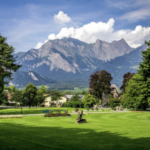Based on the information from M. H. Monroe, aboriginal people have lived in Australia for at least 60,000 years, arriving by boat from South Asia by about that time.

- Aboriginal history:
It has been suggested that the first arrivals were coastal people, basing their economies on the sea and river mouths, originally spreading around the coast and then up the rivers. If this is the case, the mouths of the rivers they would have been entering for the first time could have been hundreds of kilometers of seawards of the present coastline as the ice age that lasted from 110,000 years ago until 10,000 years ago would have left a much lower shoreline. They probably came by canoe, island-hopping as the Polynesians did many thousands of years later when they spread across the islands of the Pacific, probably from southern China.
The closest Australia came to connecting to Asia by land was at the height of the Last Ice Age, but even then, there was still a gap of about 90 km separating the 2 continents by the ocean. At the time of lowest sea level, – 60 m, at the height of the Ice Age, there would have been a chain of islands parallel to, and visible from, Timor, on the northern side of Wallacea, about 90 km from the Australian islands. There would also have been broken tongues of land jutting out from north-western Australia and from Joseph Bonaparte Gulf on the east. Between the outer islands and the tongues of land, there were stop-overs at Ashmore Reef, Cartier Islet, and Maurice and Troubadour Shoals. Once they reached the first island they could have island-hopped to the Australian mainland, though they probably didn’t realize they had reached another continent when they arrived.

- The land where time began:
If the ancestral Aboriginal People were indeed coastal dwellers, what was the incentive to expand inland? In south-western Tasmania the people lived almost exclusively on the coast for 30,000 years, based on the dating of the known sites, apparently rarely venturing into the thick rainforest. At the time of first European contact, they were still living in a narrow coastal belt between the horizontal rainforest and the sea. While they lived well on the coast, with plentiful and easily available food, why would they want to move to a habitat that was more difficult and where food was less plentiful and required more time and energy to collect? When the continental shelf was exposed there would have been rivers, possibly with deltas, lakes, and swamps, as well as the nearby sea, where they could get all the food they needed, and with very little effort.
At the time of the arrival of Europeans in Australia, it was declared an unoccupied land, as the Aboriginal People didn’t practice agriculture, so the colonists could take over without even consulting the locals. The Aboriginal People were believed by some of those Europeans to be at best, like children, who needed to be protected from themselves as well as everyone else. Others regarded them as sub-human, so there was no problem treating them as though they were animals, especially when colonization got underway and colonists wanted to take over their hunting territory for raising cattle and sheep, or farming. They were mostly tolerated as long as they didn’t try to stop pastoralists from taking their land. When they got in the way, they were often treated like animals that ate the colonists’ crops or killed their cattle for food.
It has since been realized that they did indeed farm the land, even the parts that were unusable by the colonists, and for a very long time. It has been called fire-stick farming. During their long period of occupation, they developed a system of burning off limited areas at certain times of the year, which encouraged the grass growth that supported the animals they hunted. So, while they lived by hunting, over large parts of the continent it was in effect managed hunting. In fact, they were possibly the first farmers.
“Archaeologists have also found that their stone tools have evolved over the time of their occupation.”










